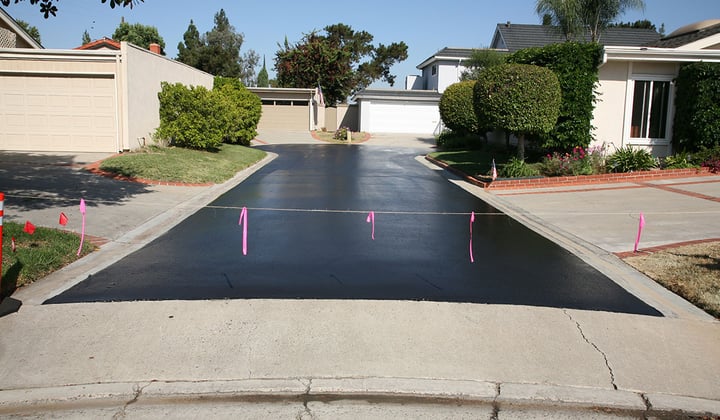Rejuvenate Your Building with Regrading and Asphalt Sealing Techniques
Wiki Article
Hot Mix Asphalt: A Sustainable Remedy for Pavement
Warm Mix Asphalt (HMA) has arised as a leading sustainable selection for sidewalk options, supplying a myriad of ecological benefits and innovative modern technologies. As the need for environmentally friendly building and construction practices expands, exploring the nuances of HMA's sustainability can supply valuable insights into the future of sidewalk solutions.Environmental Advantages of Hot Mix Asphalt
Additionally, Hot Mix Asphalt helps to mitigate urban warmth island effects. Its dark shade soaks up sunlight, minimizing the quantity of warmth mirrored back into the ambience contrasted to lighter-colored sidewalks. This can lower ambient temperature levels in metropolitan areas, decreasing the demand for air conditioning and ultimately lowering energy intake.
Additionally, Warm Mix Asphalt adds to boosted stormwater administration. Its porous nature permits water to charge and penetrate the sidewalk groundwater supplies, reducing runoff and the risk of flooding. These environmental benefits make Hot Mix Asphalt a sustainable choice for leading roads and freeways.
Energy Efficiency in HMA Production
Is energy efficiency an essential variable in the production of Hot Mix Asphalt (HMA)? Power plays a significant duty in the manufacturing of HMA, influencing both expense and environmental sustainability. One key facet of power efficiency in HMA manufacturing is the usage of warm mix asphalt (WMA) technologies.Moreover, developments in plant technologies have brought about even more energy-efficient HMA production processes. Modern plants are made with functions like recycled asphalt pavement (RAP) processing capacities, reliable burner systems, and enhanced insulation, all contributing to power financial savings. By maximizing power usage in HMA manufacturing, the sector can minimize its carbon impact while keeping top quality pavement materials. Power effectiveness is, therefore, a critical consideration in making certain the sustainability of Warm Mix Asphalt manufacturing.
Recyclability of Warm Mix Asphalt
The recyclability of Hot Mix Asphalt (HMA) is a pivotal aspect of its sustainability and lasting environmental influence. HMA is just one of one of the most recycled materials in the USA, with over 100 million lots of recovered asphalt sidewalk (RAP) being reused each year in new sidewalk building and construction. Recycling HMA supplies several environmental advantages, such as reducing the need for virgin products, decreasing energy usage during production, and decreasing the amount of waste sent to garbage dumps.The process of reusing HMA includes grating the existing sidewalk, squashing it right into smaller items, and blending it with new aggregate and asphalt binder to produce a recycled mix. This recycled mix can usually do along with or also much better than traditional HMA, while requiring less raw materials and producing reduced greenhouse gas discharges. By including RAP into new pavement projects, roadway companies can preserve natural deposits, lower costs, and minimize the ecological footprint of roadway construction and upkeep activities. Overall, the recyclability of HMA plays a hot mix asphalt considerable role in advertising lasting practices within the pavement market.

Long-Term Efficiency of HMA
Asphalt sidewalks show longevity and durability over a prolonged period, reflecting the lasting performance of Warm Mix Asphalt (HMA) The long life of HMA can be connected to its capacity to withstand heavy website traffic loads, severe weather, and the results of aging. Research studies have shown that properly designed and properly constructed HMA pavements can last for two decades or more with regular upkeep. The secret to taking full advantage of the long-lasting efficiency of HMA exists in making use of high-quality products, adhering to best methods in building, and applying efficient upkeep methods. Correct drain, routine inspections, and timely repair services are crucial for protecting the architectural integrity of HMA sidewalks in time. Furthermore, innovations in HMA innovation, such as using polymer-modified binders and warm mix asphalt, have further boosted the toughness and longevity of HMA sidewalks. By prioritizing top quality building and upkeep techniques, HMA remains to show itself as a economical and lasting solution for lasting pavement facilities.
HMA: Sturdiness and Sustainability
Demonstrating both sturdiness and sustainability, Warm Mix Asphalt (HMA) has actually ended up being a foundation in the construction of durable pavement facilities - regrading. HMA's resilience comes from its capability to hold up against heavy lots, harsh weather, and high web traffic volumes, making it a reputable selection for highways, highways, and airport terminal paths. The structure of HMA, which commonly includes aggregates, binder, and filler, plays a vital role in boosting its longevity and resistance to tear and wear
Additionally, HMA's sustainability hinges on its recyclability and energy-efficient manufacturing process. The ability to recycle reclaimed asphalt sidewalk (RAP) in brand-new HMA mixes minimizes the need for virgin products and reduces the ecological effect of pavement building and construction and upkeep. In addition, the energy efficiency of generating HMA exists in its lower blending temperature levels compared to various other sidewalk products, bring about decreased power intake and greenhouse gas exhausts.
Final Thought
In final thought, hot mix asphalt (HMA) offers a lasting service for sidewalk with its eco pleasant qualities. HMA's recyclability, power effectiveness in manufacturing, and lasting sturdiness make it an environmentally friendly option for road building and construction.
HMA is one of the most recycled products in the United States, with over 100 million loads of redeemed asphalt pavement (RAP) being reused each year in brand-new sidewalk construction.The procedure of recycling HMA entails grating the existing pavement, squashing it into smaller items, and mixing it with brand-new aggregate and asphalt binder to produce a recycled mix.Asphalt pavements demonstrate longevity and resilience over an extensive period, reflecting the long-lasting efficiency of Hot Mix Asphalt (HMA) Furthermore, improvements in HMA innovation, such as the usage of polymer-modified binders and warm mix asphalt, have actually additionally boosted the resilience and long life of HMA sidewalks. The ability to reuse recovered asphalt sidewalk (RAP) in new HMA mixes minimizes the need for virgin materials and minimizes the ecological effect of sidewalk building and construction and maintenance.
Report this wiki page